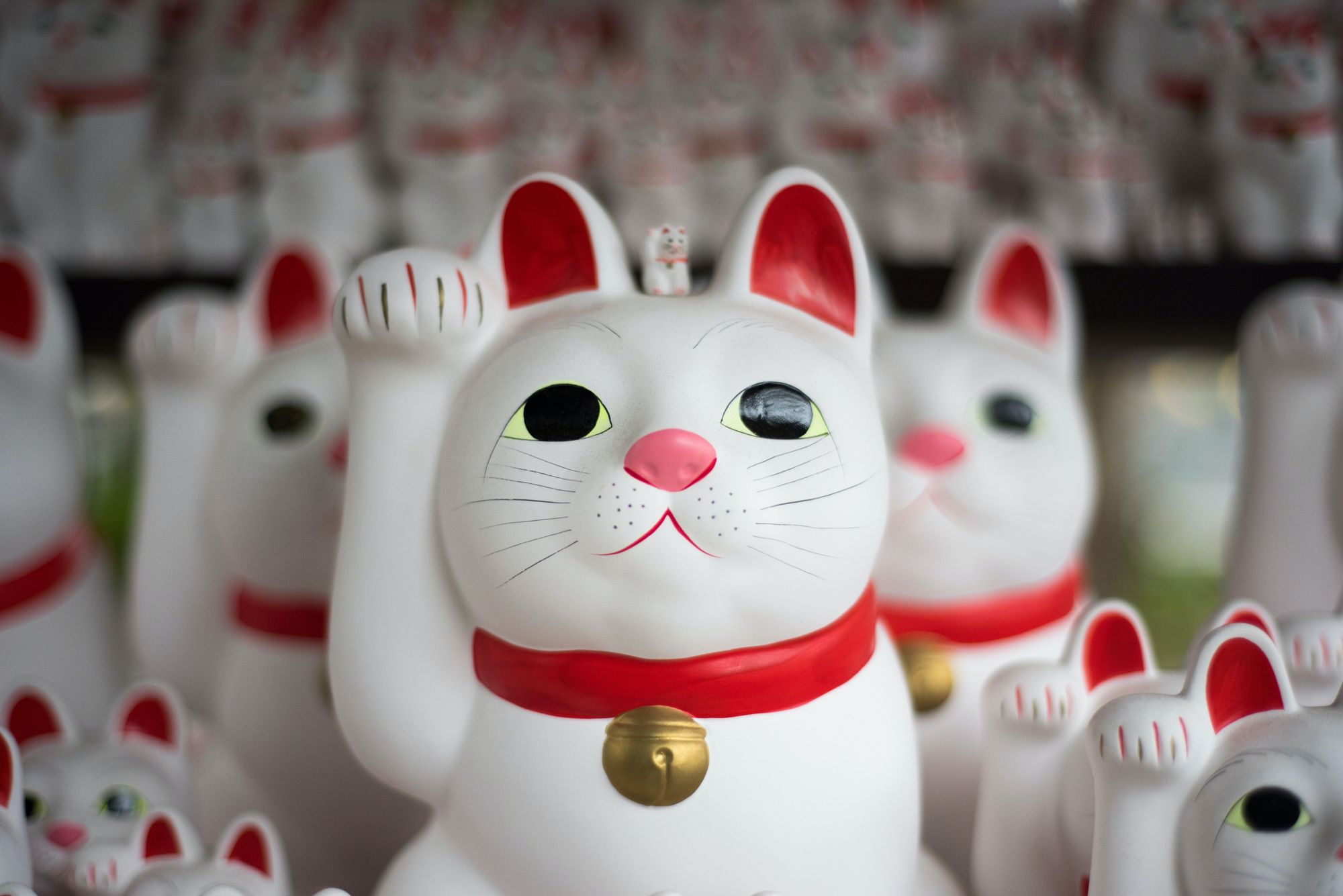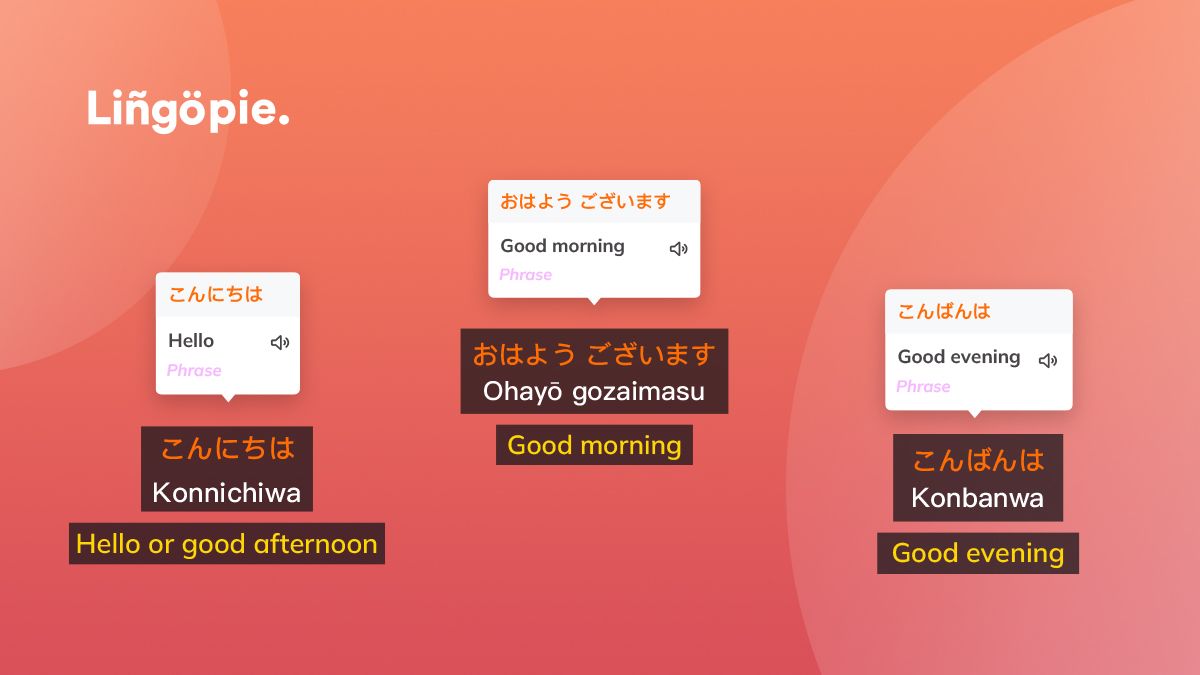If you've decided to start learning Japanese, the first words you'll need to be able to say will revolve around greeting people.
After all, how would you be able to spark up a conversation, be it formal or informal, if you didn't know how to greet someone?
With this in mind, this post is all about learning how to say hello in Japanese, and we've put together some key information to help you learn all the necessary Japanese greetings.
Before you get started, please note that for the purpose of being able to read as a beginner we will be writing in Romanji (Latin script) but also including the other three Japanese scripts: kanji, hiragana, and katakana, for your reference.
How to greet in Japanese: Japanese culture
In order to learn Japanese, you must know the correct way to greet people or you'll risk being considered rude.
Greetings, or in the Japanese language, aisatsu (挨拶), are a significant part of Japanese tradition. In fact, as you may already know, the Japanese culture has a strong foundation of politeness and respect.
As in English and other languages, how you greet someone in Japanese depends on the social context of the meeting and the level of formality.
Nonetheless, in Japan, the exchange of greetings has an even greater significance than in the western world.
The most common greeting gesture is the Japanese bow or ojigi (お辞儀), which changes depending on the situation and accompanies the verbal greeting. It's the equivalent of the western handshake.

How to say hello in Japanese formally
Konnichiwa / Hello or good afternoon (こんにちは)
Konnichiwa is the most common way to say hello in Japanese.
You can use it to greet Japanese people in semi-formal situations, regardless of their social status. However, you wouldn't use it to greet very close friends.
This greeting can also be interpreted to mean "good afternoon" and should not be used early in the morning or in the evening hours. Its literal translation is closer to "good day." It's a common misconception to think that it has the exact same meaning as "hello."
Ohayō gozaimasu / Good morning (おはよう ございます)
It's our equivalent to "good morning" and it can be used as a formal greeting in the early morning hours before 10 am. This expression is slightly more formal than konnichiwa (こんにちは).
Konbanwa / Good evening (こんばんは)
This formal greeting is used in the same way as ohayō gozaimasu (おはよう ございます) but in the evening or late afternoon, once the sun has gone down. It can be used both when first encountering someone and when departing, just as 'good evening' in English.
When wishing someone a "good night" in Japanese, you would say oyasumi (おやすみ).
How to say hello in Japanese casually
Konchiwa / Hello or good afternoon & Ohayō / Good morning
Konchiwa is the shortened version of konichiwa, which is used to say hello in Japanese when speaking with a family member, a close friend, or someone who is the same age as you. Note that the full phrase is more formal.
Similarly, if you're saying good morning in Japanese to good friends and family, you'd most likely use ohayō, which is the short version of ohayō gozaimasu.
Ossu / Hey dude or hey man (おっす)
The word ossu would be appropriate for a casual greeting among male friends or young men.
Yahō / Yoohoo or Hiya (ヤッホ)
Yahō is a very casual greeting that acts as the equivalent to ossu for young girls. Usually, it's used only among close friends.

10 other ways to say hello in Japanese
As you may have gathered by this point, there are many ways to say hello in the Japanese language. Check out the following:
Yā / Hi (やあ)
This is a simple greeting used in Japan among close friends and young people to say 'hi' or 'hi there!'
Example sentences:
Yā! Kyō wa kon'nani ī tenki... (やあ!今日はこんなにいい天気...) Hi there! Such great weather today...
Yā! Dō shita no? (やあ!どうしたの?) Hi! What's wrong?
Dōmo / Hi or hey (どうも)
The meaning of this Japanese word will vary depending on the situation. It literally means hello, good-bye, thank you, sorry, very much, somehow, and just.
Nonetheless, when used on its own it could be a casual way to greet people. It's extremely informal, so be wary of who you use it with!
Example sentences:
A, dōmo! (どうもどうも) Hi! (use twice if you're a man)
Dōmo! Subete yoidesu ka? (どうも!すべて良いですか?) Hey! Is everything okay?

Yō / Hey (よう)
In the Japanese language, yō is used to get someone’s attention and the meaning is the same as in English. It's common for men to greet friends by saying this but some girls also use it.
Example sentences:
Yō! Oaidekiteureshīdesu! (よう! お会いできてうれしいです!) Hey! Nice to see you!
Yō! Chōshi wa dō? (よう! 調子はどう?) Hey! What's up?
Ō / Hey (おう)
Ō is an informal greeting that is used in Japan mainly among young male friends. You'd hear it in a high school locker room before a game, for example.
Example sentences:
Ō! Genki ka? (おう! 元気か?) Hey! Doin’ alright?
Ō! Kinkyō wa? (おう! 近況は?) Hey! What's the latest news?
Moshi Moshi / Hello (もしもし)
Moshi moshi is the appropriate greeting for when you answer the phone in Japan.
Example sentences:
Moshi moshi. Kochira wa Ichikadesu. (もしもし. こちらはイチカです。) Hello. This is Ichika speaking.
Moshi moshi. Eiichi wa ie ni imasu ka? (もしもし. 英一は家にいますか?) Hello. Is Eiichi at home?
Harō / Hello (ハロー)
This word is actually an adaptation of the English word for 'hello'. If you say hello in Japanese this way, it'll be seen as cute and funny.

Example sentences:
Harō! Genkidesu ka? (ハロー! お元気ですか?) Hello. How are you?
Harō! Chōshi wa dō? (ハロー! 調子 はどうですか?) Hello. How's it going?
Ōi / Oi or hey (おーい)
Similar to yō, this way of saying hello in Japanese is used to call someone's attention in an informal way.
Example sentences:
Ōi! Watashi wa koko ni imasu! (おい!私はここにいます!) Hey! I'm here!
Ōi! Oaidekiteureshīdesu! (おい!お会いできてうれしいです!) Hey! Nice to see you!
Tadaima / I’m back (ただいま)
This way of saying hello in Japanese is used when you're returning home after having gone out.
Example sentences:
A person walking in: Tadaima! (I'm home).
A person who's home: Okaeri! (welcome back).
Shibarakuburi desu ne / Long time no see (しばらくぶりですね)
This greeting is used in Japanese to say hello to a friend that you haven't seen for a while.
Example sentences:
Shibarakuburi desu ne! (しばらくぶりですね!) Long time no see!
Hai, ohisashiburidesu! (はい、お久しぶりです!) Yes, it's been too long!
Saikin dō / What’s up? (最近どう)
This greeting means something like "how have you been?" or "what’s up?" and it’s a casual form of speech, employed between friends.
Example sentences:
Saikin dō? Sutekina ishō. (最近どう? 素敵な衣装!) How've you been? Nice outfit!
Saikin dō desu ka? (最近どうですか?) This extended form makes the sentence more polite.

Responding to Konnichiwa: Other Useful Japanese Phrases
Now that you've learned how to say hello in Japanese and how to navigate the greeting culture, let's look at other useful Japanese phrases.
Genki desu ka / How are you? (お元気ですか)
Genki desu ka is an informal phrase. If you'd like to turn it into a formal phrase, add o at the beginning.
O genki desu ka! How are you?
Chōshi wa dou desu ka / How's it going? (調子 はどうですか)
This is a Japanese greeting that means "how have you been doing lately?". Chōshi means somebody’s state of health.
Hajimemashite / Nice to meet you (はじめまして)
Hajimemashite. Watashinonamaeha sofīdesu. (はじめまして. 私の名前はソフィーです。) Nice to meet you. My name is Sophie.
Ikaga ōsugoshi deshita ka / How have you been? (いかがお過ごしでした。)
This can be used in a very formal situation, directed at someone who is higher in status than you, such as a professor or a boss.
Kyō wa donna ichi-nichi deshita ka / How was your day? (今日はどんな一日でしたか)
This is a friendly way to greet someone in the evening if you'd like to learn about their day.
Ōai dekite kouei desu / It’s nice to meet you (お会いできて光栄です)
This phrase is a formal way to greet someone in Japanese when you first meet them.
Ohisashiburi desu / It’s been a long time (お久しぶりです)
Japanese speakers will use this phrase similarly to how they use shibarakuburi desu ne.
If you'd like to make this phrase more casual, just say hisashiburi.
Go busata desu / We haven’t spoken in a while (ご無沙汰です)
This is a formal way to greet someone with whom you haven't spoken in a while.
Irasshaimase / Welcome (いらっしゃいませ)
In Japanese, irasshaimase is used in the context of customer service, to welcome a person who's entering a store, for example.

Summing up: Saying Hello in the Japanese Language
So, there we have it. You should now be confident saying hello in Japanese and using a variety of Japanese expressions. Your new language skills are ready to be used now that you've learned almost all the Japanese greetings!
Even if you're just looking to visit Japan and you're not learning Japanese with the goal of becoming fluent, it will be useful to know some ways to say hello.
As we mentioned earlier, if you study Japanese you'll know that politeness and respect are important when greeting Japanese people.
We've offered you a guide to navigating formal and informal situations. Now that you know, there's no need to worry since Japanese people are very welcoming.
To help you advance your studies, we also recommend watching Japanese shows and especially animes, since they're such a big part of the culture (and extremely fun!).
Why not learn how to use more words and expressions in Japanese with a 7-day free trial at Lingopie? It's the most innovative language learning platform out there, so give it a try!









